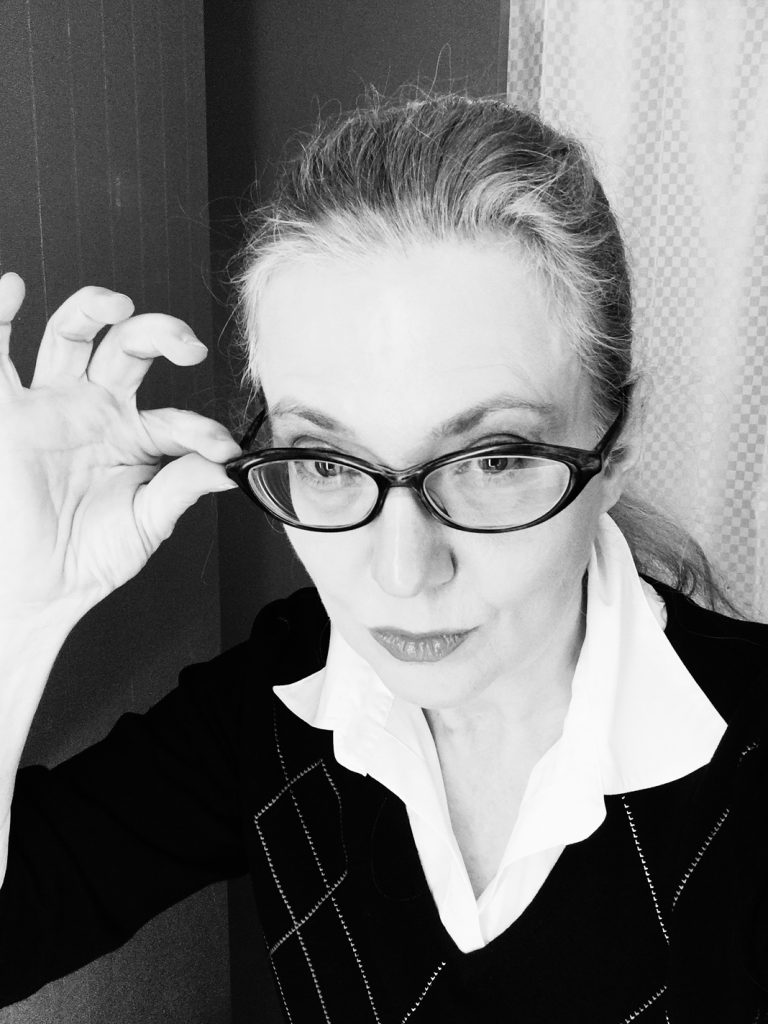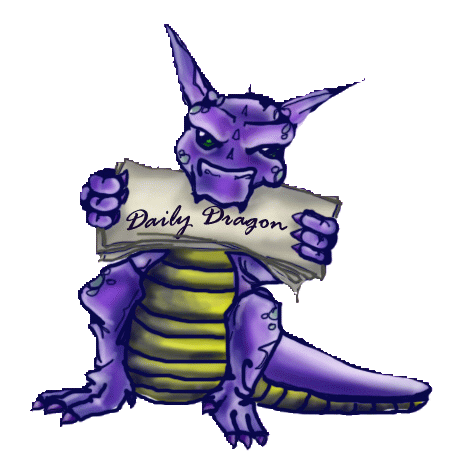
Colleen Doran is a New York Times bestselling artist and a member of the Women Cartoonist’s Hall of Fame. Her published works number in the hundreds, and her clients have included the Walt Disney Company, Marvel Entertainment, DC Comics, Lucasfilm, Image Comics, and many others. She has won numerous awards, including the Eisner and the Stoker, and has received multiple other nominations. In addition to working in comics, she has provided graphic designs to rock musicians and has spoken at many conferences and events.
Daily Dragon (DD): You’ve posted on social media about a big project you recently finished. Please tell us about it.
Colleen Doran (CD): Well, I assume you mean Good Omens? It was a monster project and took years to complete. It’s a graphic novel adaptation of the famous novel, which was later made into an Amazon Prime series. It was such a great honor to be chosen by the Terry Pratchett estate to do this work. I adapted the text and did the art as well. There was quite a bit of drama surrounding it all, exacerbated by the publicity of it being a Kickstarter record breaker. As fun as it was and as well received as it is, there was a huge amount of pressure.
DD: Backing up a good bit, when did you realize—or, maybe, decide—you wanted to work in comics?
CD: When I was twelve. Prior to that, I just assumed I’d be a doctor or an astronaut like a normal kid, or maybe I’d go work for Disney, but I didn’t really have a very clear picture of what being a working artist meant. I got very sick and was confined to bed for a long time, and a family friend brought over a big box of comics. I was aware of comics prior to this, for sure, but had little exposure to them since we lived in the country. But when I dug into this box of comics, I was set for life.
DD: What was your first job in the industry, and how did you obtain it?
CD: I did some work for an advertising agency when I was a kid. There was a woman in our science fiction club who owned the company and saw my work in the local convention art show. The writers Steve Miller and Sharon Lee were repping artists then, and they took my work around the East Coast to shows. Conventions were very different back then, not the huge events they are now, and of course, no internet. Fandom was pretty insular. I started getting small press jobs, some of which were rather dubious, but I eventually landed some work at DC Comics.
While it seems odd for kids in school to be working in comics now, you can find instances of kids getting hired when they were young teens: Jim Shooter, Kubert, Paul Levitz. We were all kids.
DD: What was the inspiration for A Distant Soil?
CD: I was a huge fan of so many silly Saturday morning TV shows like The Space Sentinels and corny ‘70s SF television like The Man from Atlantis and The Phoenix. The Legion of Super-Heroes was a huge influence. It might not seem obvious now, but if you go through my early sketchbooks, it’s clear. The characters in A Distant Soil even had superhero costumes at one point, and a few were just Legion or Teen Titans characters who morphed over time. It’s pretty funny.
DD: You independently published (or republished) the first 14 issues of A Distant Soil before moving to Image Comics. What led you to step into indie publishing?
CD: Well, the market was very different then; it was pretty hostile to works like mine and not necessarily very nice to young women. I figured I couldn’t do worse on my own, that’s for sure.
DD: What’s the status of A Distant Soil now?
CD: It’s being funded on my Patreon, and I’m restarting it now, working on the final volume. I’m also doing an A Distant Soil short story for an anthology!
DD: You’ve provided graphic designs for a number of musicians, including Tori Amos, Shaun Cassidy, Melissa Etheridge, Blondie, and The Doors. Is the process of creating what you’ve done for them the same as it is for a comic book cover, or is it different?
CD: Well, most of what I do is graphic novels based on their work, so yes, illustration is rather different than comics.
Shaun Cassidy had me do his tour poster. He was very exacting and specific about what he wanted. But on some of the other projects, we were just told what the project was and asked to come up with a picture. In Melissa Etheridge’s case, it was an homage to her guitar!
But for Tori Amos, I worked with writer Derek McCulloch, who I think is one of the finest writers in comics, and he doesn’t get enough starlight and everyone should hire him. The two stories I did with him for Tori are two of my all-time favorite pieces.
DD: Do you do most of your work by hand, or do you use digital media for some of it?
CD: Depends on the project. I still do all my drawing by hand, with very rare exceptions, but depending on the project, color is dependent on form.
On Chivalry, all the paintings were by hand. On Good Omens, all the drawings were by hand, but the colors were digital. It was one of the few times I worked with assistants, too, as I’d become very ill on the project and had to hire help.
DD: When you start a new project, where do you begin, and is the process the same for cover-only work as it is for a graphic novel?
CD: Not even close. This is such a broad question. In my opinion, illustration is easier because your focus is on one image. I usually have the leisure of making many sketches before I begin. On a monthly comic, you may not have the luxury of time for reflection and reworking ideas.
On a graphic novel, again, it depends on the project. I’ve done entire graphic novels in just a few months. In other cases, I’ve taken a year for a 50-page book and worked and reworked page after page. It depends.
A single comic page, in my opinion, is almost always more difficult than a cover.
DD: The FAQ on the website for A Distant Soil includes the statement that you do all your work by hand, with no digital aids though the original art from some covers was hand colored digitally. What is digital hand coloring?
CD: A lot of people seem to think that color is done by pushing a button. It’s not, of course. I’m not using a program to color for me, I really sit down and paint, I’m just using a digital stylus.
DD: Is there a medium you use more often than others?
CD: Pen and ink and watercolor.
DD: You’ve been candid in your newsletter about missteps during your career, some because others weren’t honest with you and some because you hadn’t learned what you needed to know to avoid the problems. Why have you decided to share this information?
CD: There was no internet back in the day. A way to share information did not exist. I really got treated badly and ripped off badly, going back to when I was a teen.
I recall some woman pro admonishing me for being stupid due to one of my contract situations, as if you’re supposed to know the details of a termination clause when you’re a teenager and even the lawyer you hired didn’t know what that entailed.
It’s just galling how arrogant and smug people get about this stuff, and since this woman went right on to work with people who ripped me off over a decade later and then came crying to me about it when she got treated badly there, I just rolled my eyes.
Most people can’t relate to other people’s experience. They just can’t see themselves being anything but a hero. They also think there’s a magic formula to keep from getting ripped off.
But there isn’t. Contracts are useless if you don’t have the resources to enforce them. That’s the message.
I used to put a lot of energy into industry activism, but I’ve finally stopped trying to swoop in and save people from themselves. They have to learn from their own mistakes in the end. But I did my best.
DD: What advice would you give an artist starting out today with the goal of working in the comics industry?
CD: Stop looking at the peak of the long tail, assuming that you’re going to get in comics and get the Netflix deal and be a millionaire when you’re 24. It’s difficult to make a living in all the arts, not just comics. Make comics because you love it, but be realistic about possible outcomes.
My pro generation was not wealthy or privileged, but I’m afraid a lot of the people who have the advantages in the industry nowadays are.
DD: You’ve done several projects involving Wonder Woman. What do you see as the essence of that character?
CD: Goodness. Innate goodness.
DD: At one point, you were active in Legion of Super-Heroes fandom. What do you like about the Legion?
CD: I loved being a kid reading a comic about kids who were out there doing great things, saving the day. It just felt wonderfully optimistic and joyous, and there was a character in it for any kid to live. I still love the classic Legion.
DD: Thank you for your time.
You can find more information about Colleen Doran and her work by visiting her website, https://www.colleendoran.com, and her social media:
